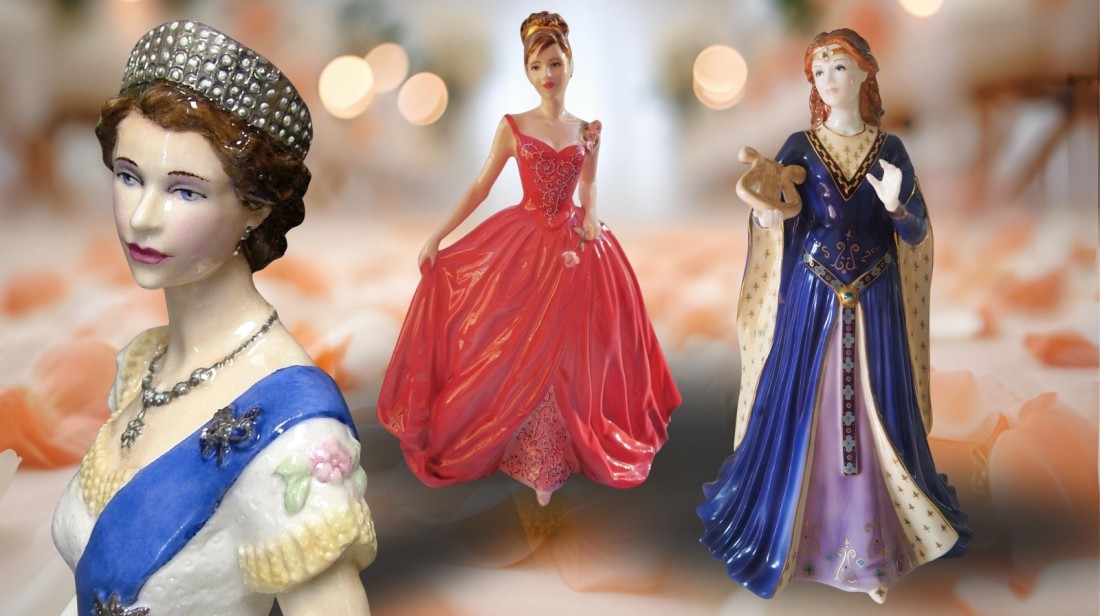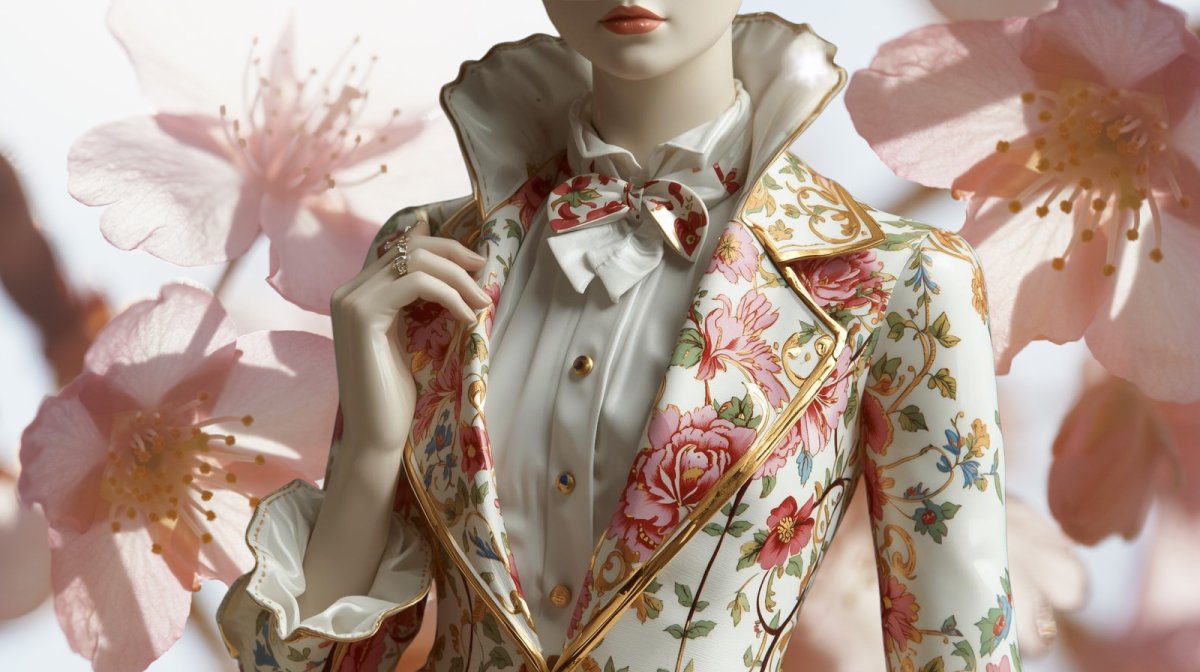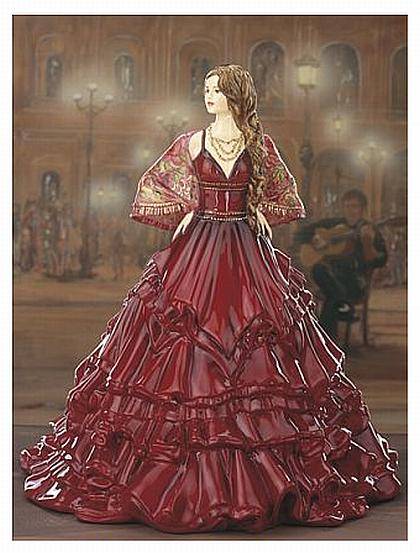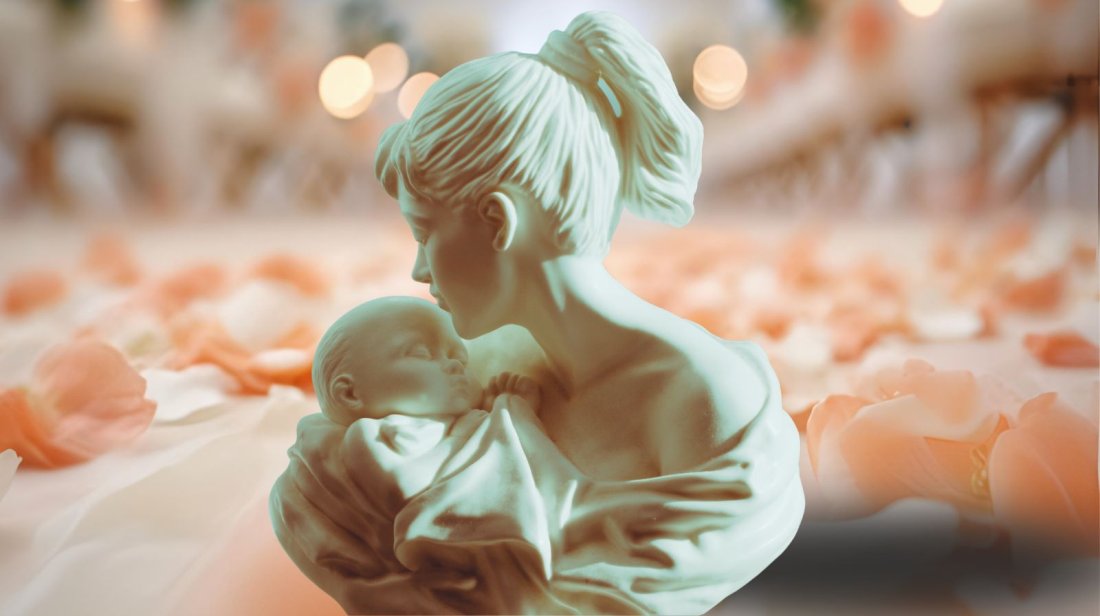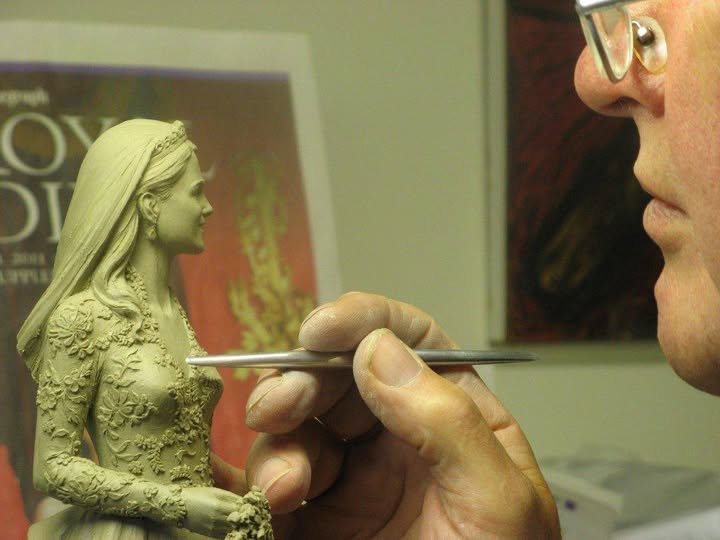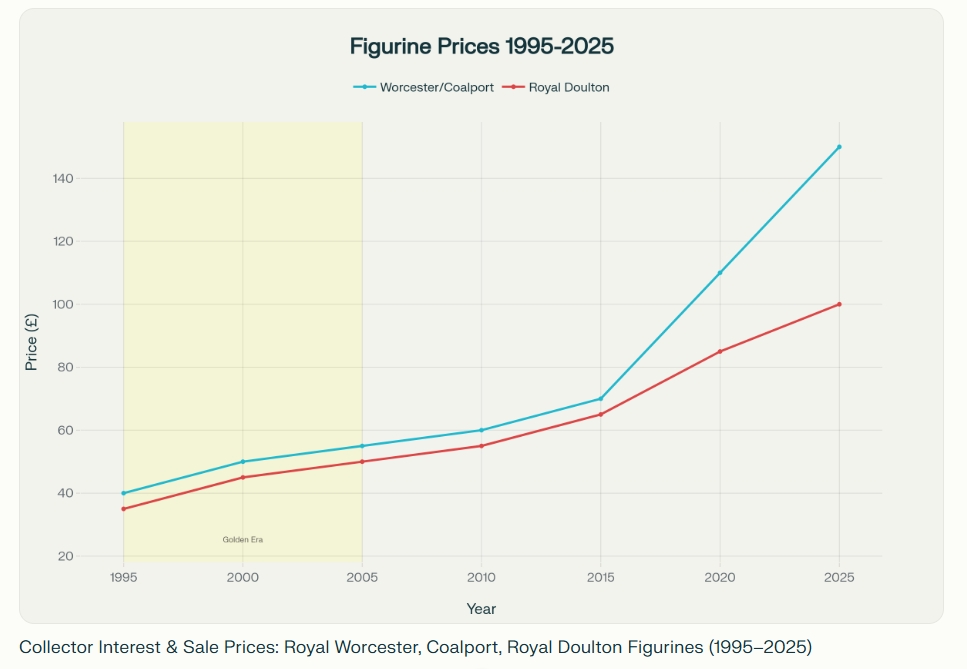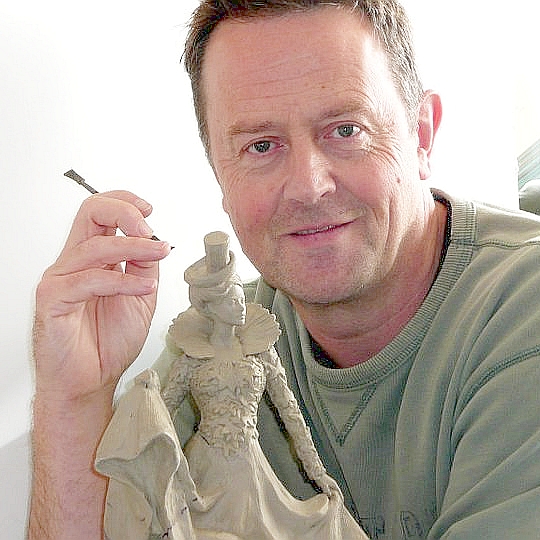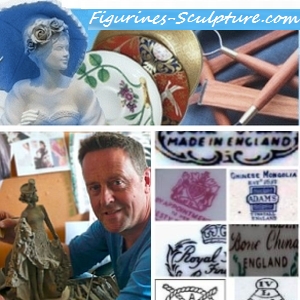- Home
- Collecting & Sculpting
- Collectible Figurines
Collectible Figurines — Expert Guide to
Fine Bone China Artistry & Investment Value
Collectible figurines - The ultimate guide.
Introduction
Welcome to the definitive collector's guide to collectible figurines. As an insider and sculptor for houses like Royal Worcester, Coalport and Royal Doulton. I know that whether you're searching for investment value or the perfect piece to complete your display, the answers lie more than in material science (bone china/porcelain), maker heritage (the famous names), it lies in artistic skill and technical brilliance. This guide covers everything: from what makes a genuine bone china collectible figurine truly special and worth money in today's market, to a full breakdown of the global figurine market (including looking at makes like Lladro, Hummel, and the current Pop Culture trends. Most importantly, you will learn how to identify value in your own collection and gain direct access to live, authentic listings, starting with my own portfolio in the gallery below.
Current Studio Work
My practice continues to evolve across sculpture, restoration, and graphic art inspired by mid-century travel and fantasy themes.
Table of Contents
- Gallery — Selected Figurines by Peter Holland
- What Makes a Figurine Collectible?
- The Makers Behind the Magic — Britain’s Finest Figurine Houses
- How to Identify Quality in Collectible Figurines
- Insider Insight — How Sculptors Create Limited Editions
- The Collector’s Eye — Trends and Market Value
- Where to Find Collectible Figurines Today
- Popular Collector Figurine Types Outside English Bone China
- Collector’s FAQ
- About the Author — Peter Holland
Gallery: A Selection of Collectible Figurines by Peter Holland
Peter Holland's Sculpture Portfolio: The Journey From Raw Clay to Finesse
As a master sculptor, my life's work has been to capture a fleeting moment and preserve it in bone china. The true value of a collectible figurine lies not just in its beauty, but in the story and passion of its creation. On this page, I share a portfolio of a few of my past works, and offer an insider's look into the inspiration, technical challenges, and journey from a simple block of clay to a treasured heirloom. This is my story, through the pieces I created.
The Stories Behind the Sculptures
Each piece tells a unique story of artistic vision, technical mastery, and the delicate balance between imagination and craftsmanship.
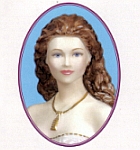
Charlotte
This piece, named after my eldest daughter, was a truly personal joy to create. The challenge was to capture her innocent, gentle expression in clay—a moment of childhood that would resonate with collectors. I spent weeks refining the delicate features and the flow of her dress, knowing it would become a timeless representation of a sculptor's love for his child.
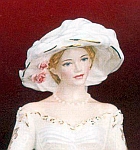
Louisa
Coalport's 'The Royal Garden Party' was a collaboration that pushed the boundaries of decoration. My job was to sculpt a figurine that was not only elegant on its own but also served as a perfect canvas for a pioneering 'decal-on-lace' method. The intricate detailing on her dress was a technical challenge, requiring precision in the initial clay work to ensure the decals would settle perfectly during the firing process.
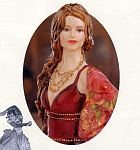
Rosita
Rosita was a piece I created for Royal Doulton. My aim was to sculpt a piece that embodied both romantic beauty and a sense of movement. The flowing lines of her dress were the most enjoyable part to create, with each curve designed to catch the light and give the impression of a dance captured in a single moment.
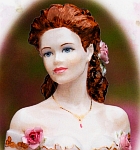
A Dream Come True
This Coalport piece was part of a very special collaboration with Royal Wedding dress designer Elizabeth Emanuel. Her sketches were full of a unique, ethereal vision, and my task was to translate that flowing fabric and delicate elegance into a tangible, three-dimensional form. It was a wonderful challenge blending the worlds of fashion and sculpture.
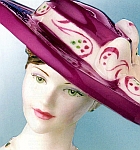
Frances
'Frances' was another of Elizabeth Emanuel's designs and was crowned a Coalport Figurine of the Year. The grace in her posture and the intricate folds of her dress were the most rewarding aspects to sculpt. It's a piece that truly demonstrates how collaboration between a designer's vision and a sculptor's skill can create something extraordinary.
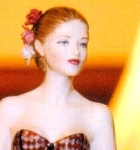
Catherine
This Royal Worcester figurine was created for a very special 250th-anniversary celebration. It was a true honor to sculpt a piece commemorating such a milestone for one of the UK's most historic fine china companies. The design was a nod to tradition, and my work focused on bringing a sense of timeless dignity to the piece.
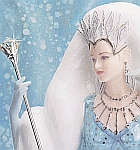
The Snow Queen
Part of the Royal Worcester Fantasy Collection, the Snow Queen was a joy to sculpt. My main challenge was to make the fantasy tangible—to capture the cold elegance and magical presence of the character in the warm softness of clay. The intricate details of her robes and crown were a testament to the artisans who brought her to life in bone china.
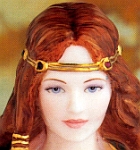
Princess Tara
Princess Tara, from the 'Celtic Princess' collection, was a particularly popular piece. The sold-out edition of 7,500 was a testament to the beautiful design. My focus here was on capturing the historical and mythological feel, giving her a sense of ancient grace and strength that resonated deeply with collectors.
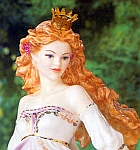
Titania, Queen of the Fairies
Titania was a perfect partnership between the designers, the artisans at Royal Worcester, and myself. My goal was to convey the delicate, otherworldly nature of the Queen of the Fairies. The challenge lay in creating a flowing, dynamic pose that felt both ethereal and structurally sound in clay, a true dance between fantasy and reality.
End of Portfolio Gallery
Each sculpture represents countless hours of dedication, from the initial clay modeling to the final fired piece. The journey from concept to collector's treasure is what makes each figurine truly special.
What Makes a Figurine Collectible?
From an insider's perspective, the difference between a trinket and a treasured collectible comes down to three critical factors that go far beyond surface appeal. The convergence of artistic intent, material mastery, and manufacturing rarity make up the crux of what creates value.
Mass-Produced vs. Artist Sculpted
Most figurines you see today are mass-produced resin or cheap ceramic, quickly moulded and painted by machine. A true collectible, particularly one from respected houses like Royal Worcester and Coalport, begins life as an original clay model (also known as the master sculpt). This is modelled by a dedicated artist who has learned his trade through blood, sweat and tears. This original sculpture is used to create the detailed master moulds, ensuring every curve and gesture is deliberate and executed with the finesse of the original. This process is the foundation of artistic merit.
Material: Bone China vs. Resin
The material alone separates the fine from the fleeting. Resin is basically glue - opaque, cheap, and lacks heritage. Bone china, an English innovation, is composed of bone ash, feldspar, and china clay. When fired correctly (vitrified), it achieves an unrivaled whiteness, strength, and that crucial true bone china translucence, the hallmark of quality that collectors look for when a piece is held to the light.
Sculptor's Note: The Power of Translucency
The firing process for bone china is unforgiving. If a piece fails to achieve full vitrification and translucency, it is either scrapped or marked as a 'second'. When you see that glow you know there has been a successful fusion of high-quality materials under extreme heat and a rare technical synthesis has driven quality and value value.
Glaze, Translucency, and Kiln Finish
The glaze is that magic visual that glimmers its reflected light like the flicker of a jewel. It seals and protects the piece and on prestige fine china collectible figurines, the glaze is applied uniformly and fired to a high temperature, ensuring a smooth, flawless surface free of pinholes or cracking. Translucency is not easy to achieveand has to be perfected on the the glost firing, when the china body vitrifies (turns glass-like). Any error in material mix or kiln temperature means a failed piece. Rarity is therefore truly built into the difficulty of the process.
The Makers Behind the Magic — Britain’s Finest Figurine Houses
The prestige of a maker acts as a quality assurance stamp. Collectors prize these houses not just for their materials, but for their centuries of dedicated craftsmanship and artistic direction.
Royal Doulton
Known globally for their prolific heritage of Royal Doulton figurines, they defined the 20th Century market. Their figurines, famous for their detailed character modeling and vibrant underglaze painting, hold consistent value, especially early examples and figurines from their HN series. They remain a staple of any serious collection.
Royal Worcester
The first of the true English porcelain makers, Royal Worcester bone china figures and busts are valued for their exceptional artistry and historical rarity. My own work with them varied from pretty lady figurines to busts, both for their factory directly or via development via the Compton & Woodhouse marketing agency and retailer - emphasizing the material’s purity. Look for pieces marked Compton & Woodhouse for the highest values.
Coalport
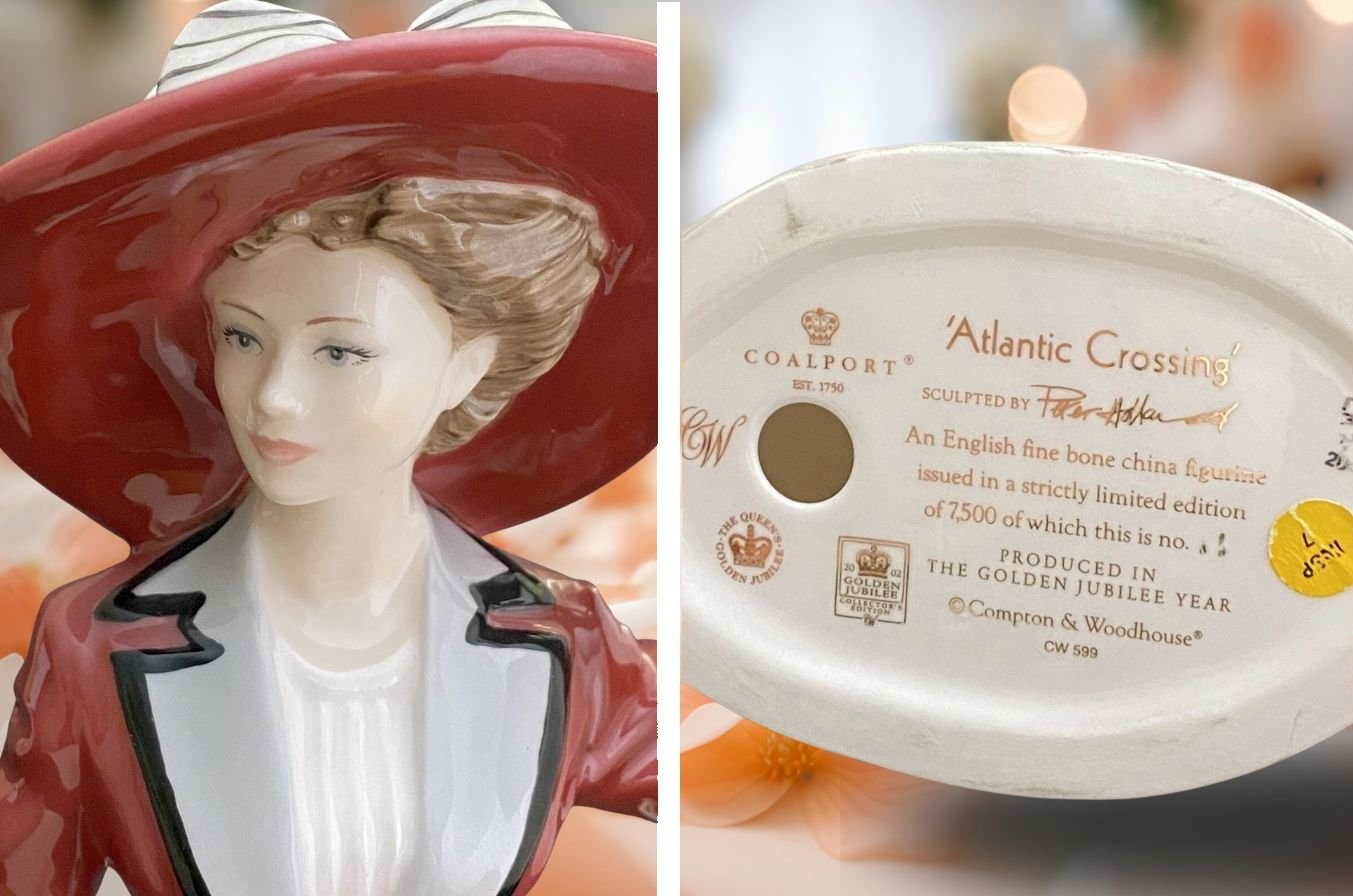 Coalport's rare and sought after Atlantic Crossing by sculptor Peter Holland
Coalport's rare and sought after Atlantic Crossing by sculptor Peter HollandCoalport’s long history is marked by ornate designs and beautiful coloring, becoming highly fashionable in the Victorian era. Coalport figurines often appear in limited editions, and the older, more complex pieces, especially those featuring lace-like detailing, are highly sought after by today's collectors.
Compton & Woodhouse
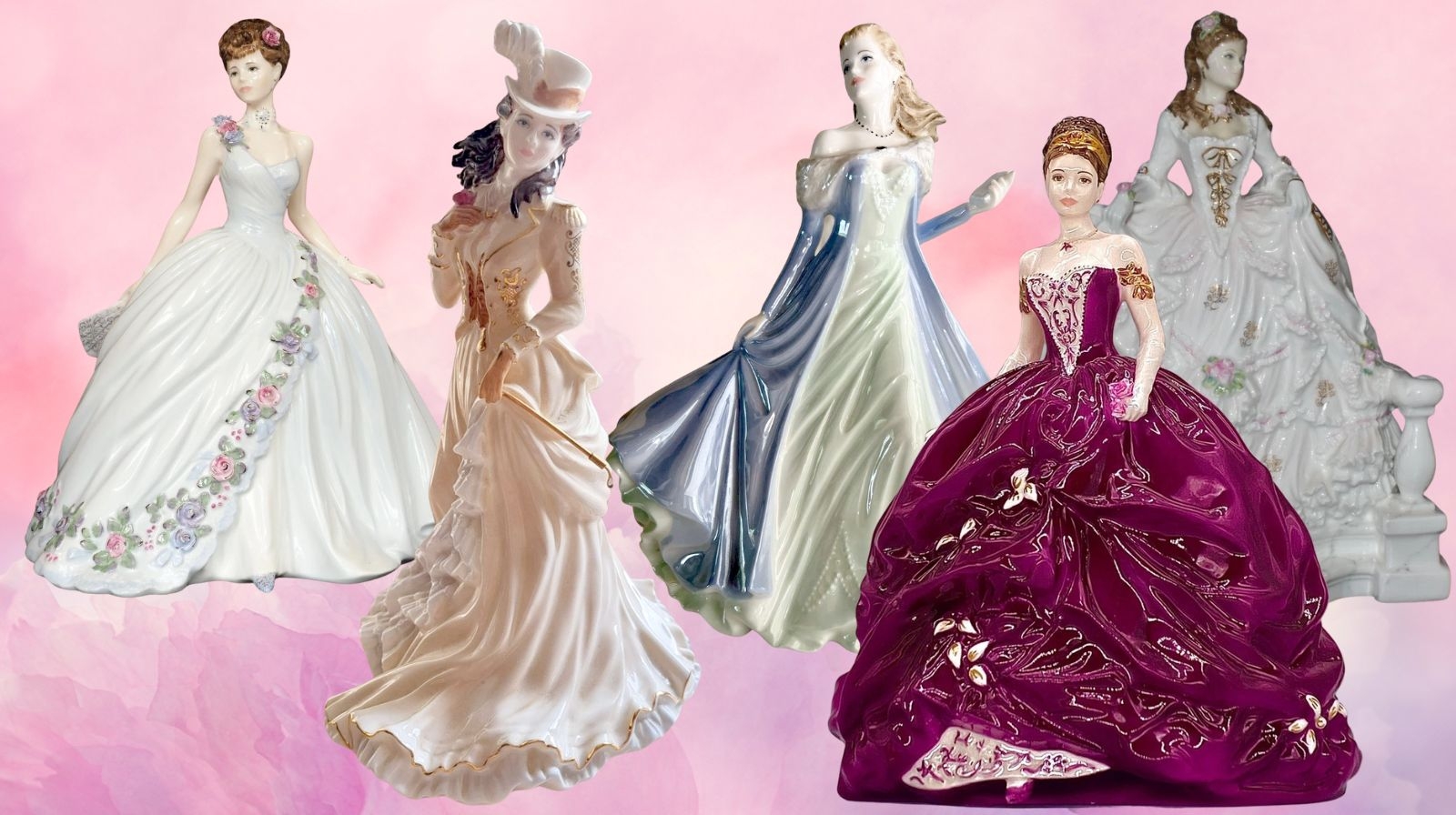 Compton & Woodhouse commissioned bone china pieces are a cut above.
Compton & Woodhouse commissioned bone china pieces are a cut above.Primarily known as a retailer and commissioner of limited-edition pieces, based around a direct marketing organisation, Compton & Woodhouse worked with houses like Royal Worcester, Royal Doulton and Coalport to produce highly exclusive collections. Figurines with the C&W backstamp often signify a controlled, lower production run, as well as highly emotive and imaginative themes and polished design input which adds significantly to their connoisseur and scarcity value in the secondary market today.
These figurines are the ones that stand the test of time in terms of continued collectibility and high value, despite a different market to the one in which they were commissioned and made, more than a quarter of a century after their heyday.
Why are C&W better?
The reason is that Compton had a core product development team, including a small group of the best sculptors in the land lead by true master John Bromley - a legend in the industry in the second half of the 20th century - and C&W had a leadership dynamic that was driven to perfection in terms of design, and it shows. This combination has been rarely matched in the history of ceramic production.
While at the same time, the top sculptors were producing separate work directly for the three main factories, the factory commission work never quite had the same oomph.
C&W had the power over the factories to tell their executives & bosses to up their game in terms of what was possible in terms of bone china production. Had their own in house product development teams told them this, they would have given them short shrift. So with Compton, there was no reigning back of creative flair either from the design team or the sculptors themselves.
How to Identify Quality in Collectible Figurines
When assessing a piece, turn it over. The base tells a story of authenticity, quality control, and rarity. Use this quick guide to determine if a figurine is a true collectible. Is the brand well known, is the artist/sculptor highly regarded, is there an association with the golden era of production? (Example: Compton & Woodhouse 1990's-2000s).
Then, take a long hard look at it. How crisp is the detail? How meticulous the drapery? Does the drapery have authentic flair, can you see the real studied movement of it. All the great sculptors have the ability to put the x-factor into drapery that makes something hard and solid (porcelain) look soft and movement-kissed.
Is the lady a real gal? All the top modellers can instill a real persona into that small bundle of feldspar. It is a mystical thing, not all those who try can do it - even if technically gifted.
Above all, is the theme and title of the piece captivating and telling a story. A story each person that sees it will create inside their heads? We sometimes need to escape the mundane and the annoying. She might help us do this or even go back to a time we looked into love's eye.
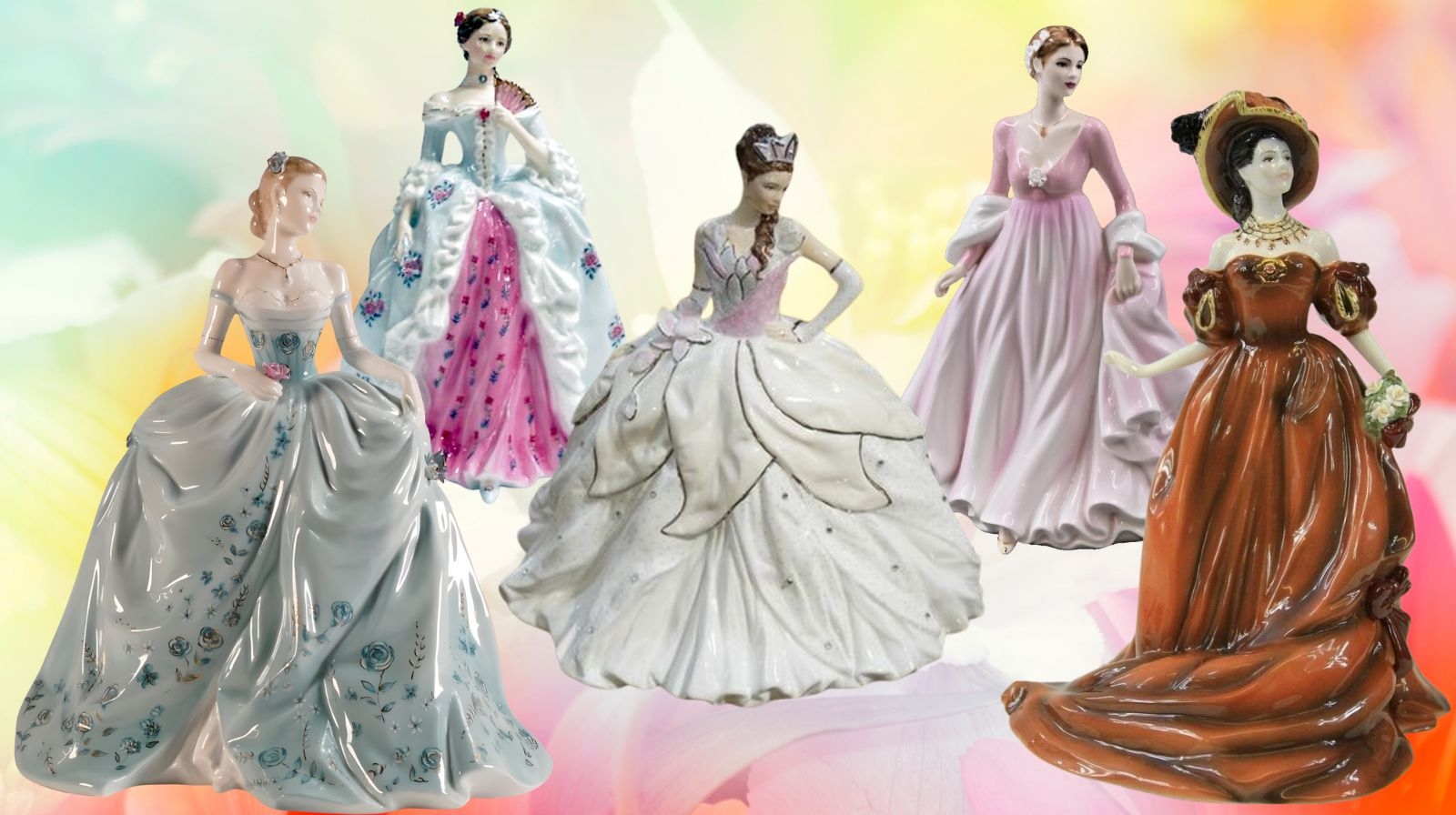
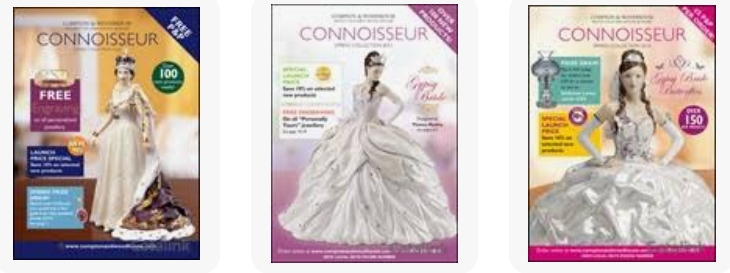 The C&W Connoisseur effect
The C&W Connoisseur effect| Factor | What to Look For | Why It Matters |
|---|---|---|
| Maker’s Mark | Crisp, clear, impressed, or finely printed base mark. | Confirms authenticity and manufacturer. A blurred mark may signal a lower-quality second or a fake. |
| Bone China Quality | Translucence under direct light (holds up to a bright lamp). | True bone china vs. stoneware/ceramic. Opaque means a lower-value material. |
| Paintwork | Delicate, thin brushwork with no bleeding between colors. | Indicates meticulous hand-painting and finishing by a skilled artist, not a decal. |
| Limited Edition Number | Handwritten numbering, e.g., "No. 47 of 250." | Proves scarcity. The lower the edition number (e.g., 1/50), the higher the collector appeal. |
For detailed visuals of specific marks, see our pottery marks guide here.
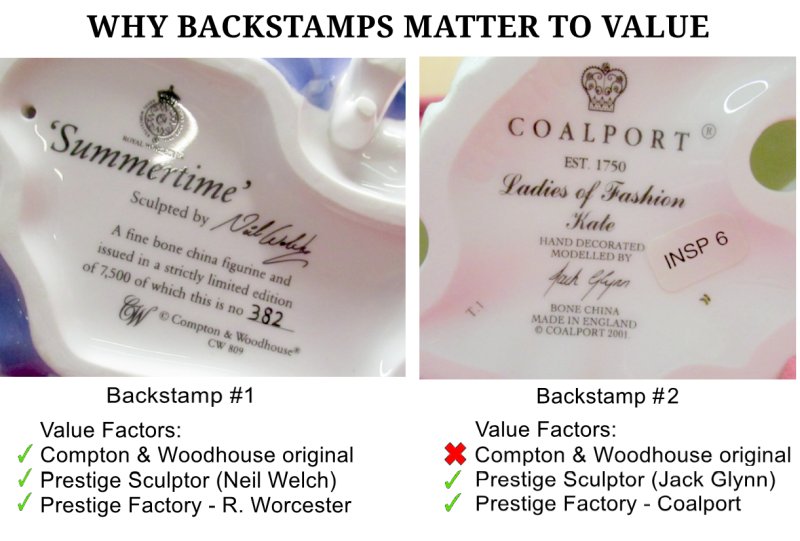 A C&W backstamp is one of the best indicators of true collectible quality
A C&W backstamp is one of the best indicators of true collectible qualityInsider Insight — How Sculptors Create Limited Editions
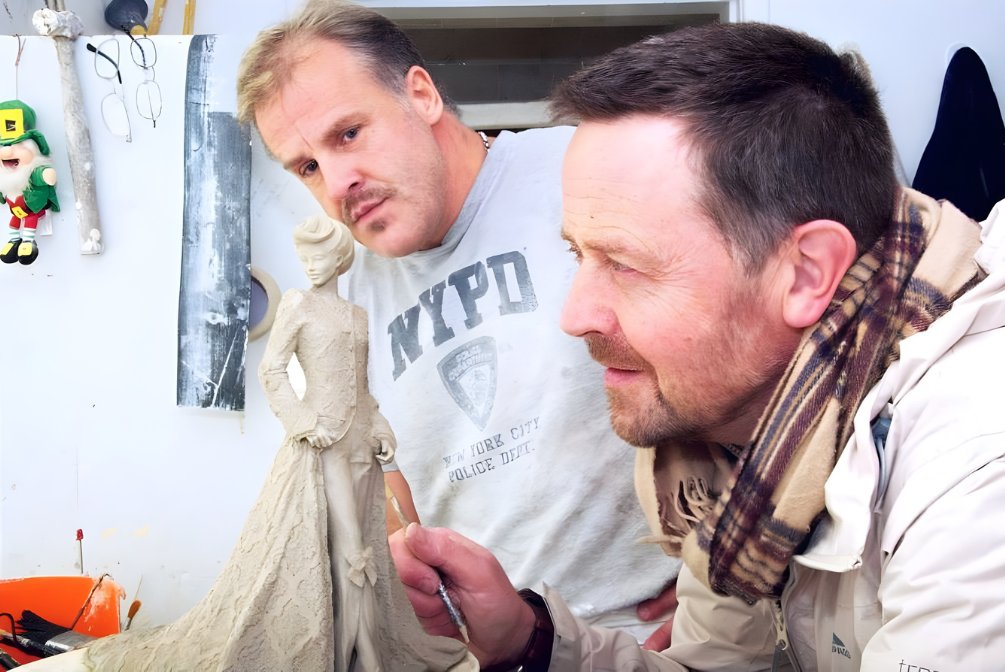 From clay to kiln — the sculptor’s journey behind collectible figurines
From clay to kiln — the sculptor’s journey behind collectible figurinesThe journey of a fine bone china figurine is a slow one, steeped in skill and patience. As a sculptor, my role begins with a lump of clay, but the true work is making that clay live.
A limited edition begins with the initial modeling, often requiring weeks or even months of meticulous work to capture the emotion and flow of the design.
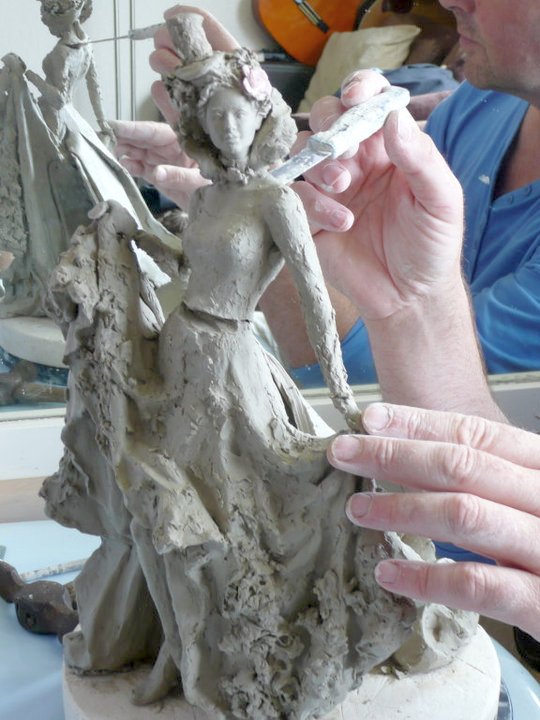 The early stages of clay sculpture includes brutally chopping and changing posture to get the right flow state of the pose
The early stages of clay sculpture includes brutally chopping and changing posture to get the right flow state of the poseThe early stages of a clay sculpture are crucial to the piece ever having a chance to become a connoisseur collectible. The sculptor has got some detail on the piece, for example the face being there is a great way to establish personality early on. The pose might be adjusted (literally chopped about with a knife) several times before it exudes the right charisma. Charisma by knife point!
The sculptor will only then begin the think about the tidy up and putting fine detail on. Some sculptors may be less prepared to experiment for best posture in this way, and go more for neatness and technical purity from the outset. I never saw a John Bromley rough that wasn't virtually finished but for a few bits of detail. Mine tended to be chaotic until such time as she was doing her thing.
Once the original clay model is perfect, it is broken down into dozens of smaller components to create the plaster master molds. These moulds will only be used a finite number of times. This production limit is the source of the figurine's scarcity. Once the limit is reached, the master moulds are deliberately destroyed, guaranteeing no more of that piece will ever be made.
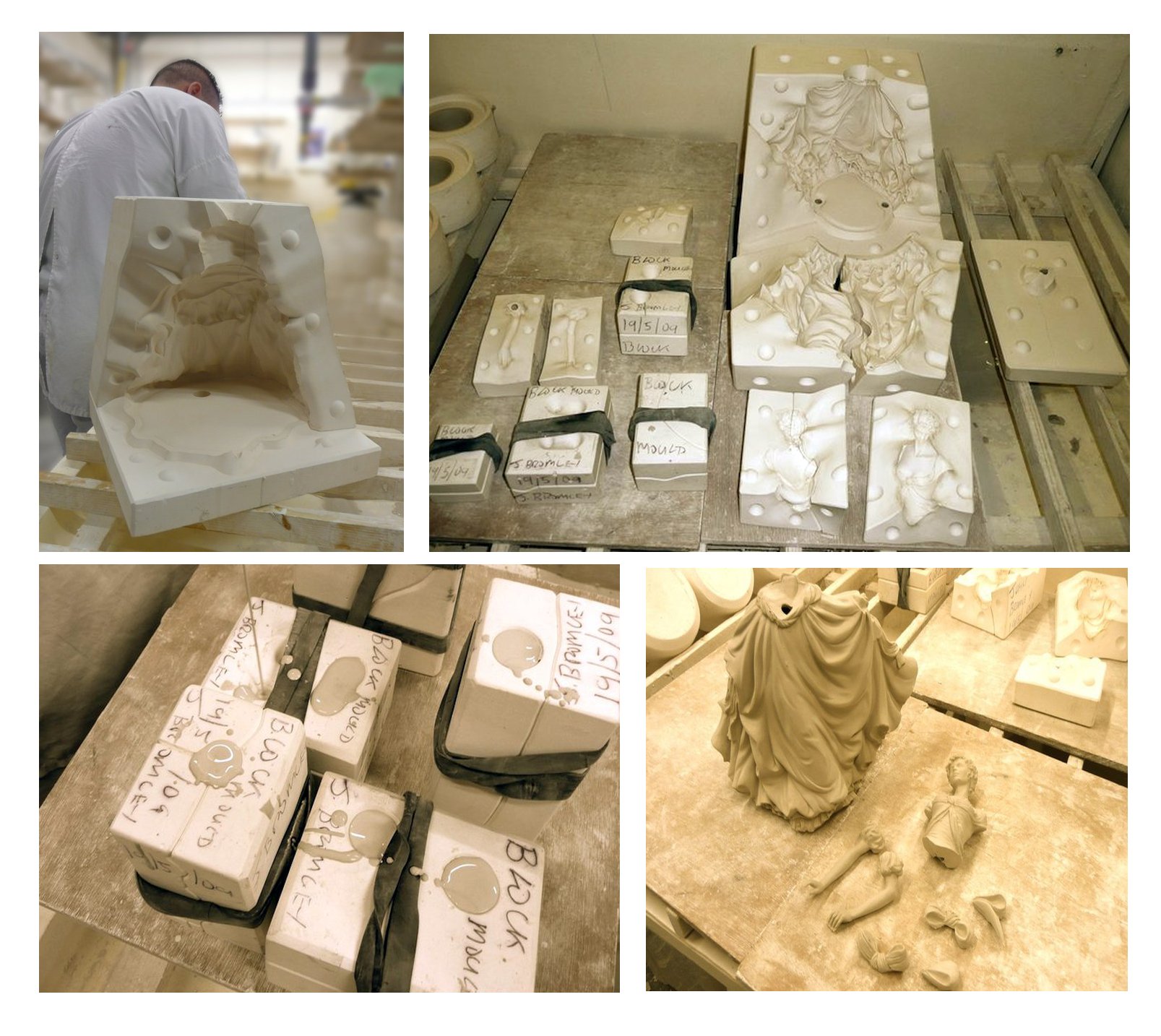 Slip casting a complex figurine. Plaster moulds allow no 'undercuts' - so many moulds have to to cast to get all the angles.
Slip casting a complex figurine. Plaster moulds allow no 'undercuts' - so many moulds have to to cast to get all the angles.Following casting, each piece is individually trimmed, fired multiple times (bisque, glost, and decorating), and meticulously hand-painted. This entire process, from the initial sketch to the final signed piece leaving the kiln, is what justifies the prestige and enduring value. Perhaps not just a commodity but a legacy proposition.
The Collector’s Eye - Trends and Market Value
Becoming aware that there seemed to be a growing interest in my figures on the UK selling platforms, and being personally approached from fine china marketers abroad, I sensed there may be a resurgence of interest in prestige bone china collectible figurines, so I got an AI to run a market analysis as at October 2025. The results are fascinating.
Market Analysis by CoPilot LLM:
The market for fine bone china is seeing a modern renaissance. Collectors are drawn to the durability, the British craftsmanship, and the emotional connection to heritage. While the market is broad, the strongest values are held by limited-edition pieces from the most reputable makers and sought-after sculptors.
The prestige bone china figurine market from the 1990s–2000s era, led by Compton & Woodhouse, is actively traded and growing on platforms like eBay and Etsy. The most sought-after pieces are from Royal Worcester, Royal Doulton, and Coalport, with top artists being John Bromley, Peter Holland, Jack Glynn, and Neil Welch with support from Martin Evans.
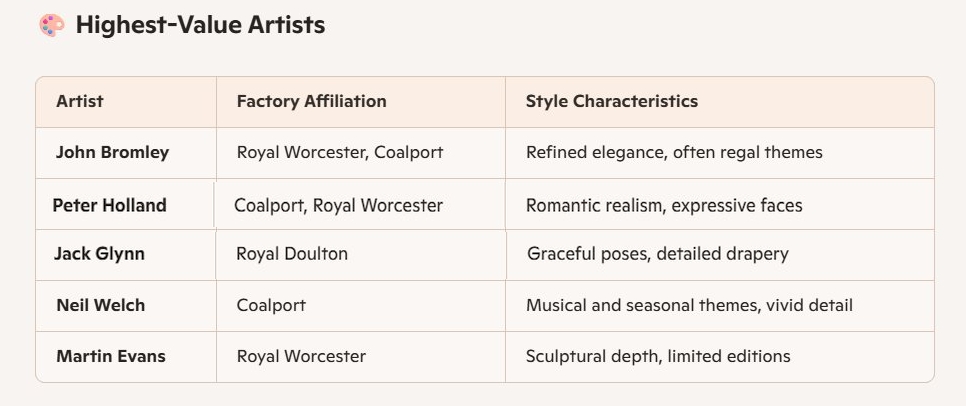
Market Focus by CoPilot LLM:
The market focus for the most valuable 'Golden Era' of English bone china figurines, in terms of today's collectible figurine market, was the period: 1990s–2000s 'Prestige or Connoisseur' figurines from the house of retailer Compton & Woodhouse.
The dominant factories utilised by designers/commissioners/retailers Compton & Woodhouse were: Royal Worcester Coalport and Royal Doulton.
The three senior prestige artists are Bromley, Holland and Glynn. All artists created clay masters for all three factories, but the market sees certain correlations in the current platform mix of offerings. John Bromley sees Royal Worcester, Coalport with the figures showing refined elegance, often with regal themes. Bromley also worked with Doulton via C&W, but did many Doulton stamped figures directly with the factory also. He was under a stricter design brief under C&W, and more free with his interpretations under direct factory commissioning.
Jack Glynn and Peter Holland both worked with Coalport directly, but it was under the C&W banner that they seemed to create their most valuable works as we see in the collectible figurine market today. Holland was mostly affiliated with the Coalport & Royal Worcester brands with figurines of romantic realism and expressive faces.
These three artists in particular, are favored by collectors for their craftsmanship and association with Compton & Woodhouse’s prestige line. Their work commands higher resale values and consistent demand on secondary platforms -🛒
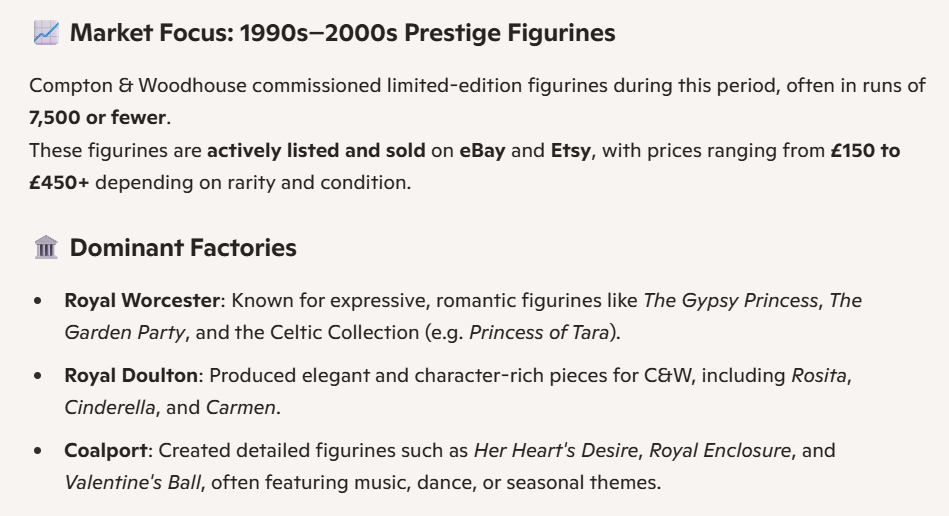
Compton & Woodhouse commissioned limited-edition figurines during this period, often in runs of 7,500 or fewer.
These figurines are actively listed and sold on eBay and Etsy, with prices ranging from £150 to £450+ depending on rarity and condition..
- Royal Worcester: Known for expressive, romantic figurines like Jade, Sweet Dreams, and Princess of Tara.
- Royal Doulton: Produced elegant and character-rich pieces for C&W, including Summer and Carmen
- Coalport: Created detailed figurines such as Topaz, Sonata, and Lady Rose, often featuring music, dance, or seasonal themes.
Active Platforms📊 Summary
- eBay UK & Ireland: Hundreds of listings for C&W figurines, especially from the artists above. Examples include Emma by Neil Welch (£115), Topaz by Coalport (£31), and Jade by Royal Worcester (£128).
- Etsy UK: Boutique sellers offer curated selections, often with original boxes and certificates. Figurines like Sonata and Sweet Dreams are prominently featured.
The collector market for Compton & Woodhouse figurines from the 1990s–2000s is robust and platform-driven, with Royal Worcester, Royal Doulton, and Coalport as the leading factories. John Bromley, Jack Glynn, Peter Holland, Neil Welch, and Martin Evans are the most valued sculptors, and their work is actively traded and appreciated by modern collectors.
Sources: eBay, Etsy
The collector market for high-end English bone china is having a major up-spike renaissance
Note: Prices represent a smoothed median/average across a range of retail/completed sales values from UK/EU platforms (not auction highs/lows) - some examples can fetch considerably higher than the median.
Sought-After Sculptors & Markets
- Top Sculptors: Peter Holland (myself), J.G. Bromley, Jack Glynn, Leslie Harradine (Doulton), Shane Ridge (Worcester).
- Investment Pieces: Generally, limited editions of under 500 pieces that are signed and are in perfect, 'mint' condition.
- Active Markets: eBay (for daily listings), WorthPoint (for valuation data), and specialist auction houses (for high-value rare pieces).
Many fine bone china figurines, including my own Royal Worcester and Compton & Woodhouse limited editions, appear regularly on collector marketplaces.
Here are the live listings of current collectible figurines from Royal Doulton, Coalport, and others on eBay:
Where to Find Collectible Figurines Today
Here's the thing. The secondary market is where the vast majority of rare and limited-edition collectible figurines are found. Knowing where to look is key to securing an investment piece or completing a collection.
Market Insight
Genuine bone china figurines from top makers like Royal Worcester, Coalport, and Royal Doulton regularly appear in collectors’ markets and on platforms like eBay. Always check the maker's mark and condition carefully before purchasing.
Popular Collector Figurine Types Outside English Bone China
While the focus of this guide is on the heritage and investment value of English bone china, it’s important to acknowledge the vibrant and diverse global collector market. The term 'collectible figurine' now spans a huge range of materials and genres, often driven by pop culture and emotional connection rather than just material quality.
Porcelain and Ceramics from Europe & Asia
- Capodimonte (Italy):- The original Capodimonte works ceased production in Napoleonic times, and now signifies a general romantic Italian style rather than a factory. It is renowned for intricate Baroque styling, classical themes, and ornate, flowery details. These are still prized by collectors over a variety of different studios and makers.
- Material Fact: Florence figures are not true porcelain. They are made from a high-grade resin compounded with porcelain dust (often called “cold-cast porcelain”). This provides the look of delicacy and fine finish.
- Prestige: Sculptors like Hamilton and Armani created many sought-after pieces, styled in the tradition of Capodimonte (which signifies a style, not a factory).
- Market Status: Florence figurines by Armani and Hamilton are actively collected. Typical resale values cluster between £60–£160, with rare Disney licenses or certain Hamilton sculpts reaching up to £700+ in mint condition. The resin base can act as a ceiling, preventing prices from competing with premier fine bone china.
- Lladro (Spain):- Famous for their contemporary, dreamy sculptures, often featuring pale, single-color glazes, they are collectible among international buyers for their sentimental and elegant aesthetic.
- Royal Copenhagen (Denmark), Hummel/Goebel (Germany):- Highly collectible among international buyers, these makers emphasize cultural scenes, children, and distinctive regional artistry.
FLORENCE sculture d'arte, Hamilton, and the Resin Debate
Florence figurines, especially those sculpted by David Hamilton and the Italian master Giuseppe Armani, stood as one of the prestige collectible lines of the late 20th and early 21st centuries. Their story is a fascinating offshoot of the porcelain versus resin debate:
Summary Table: Florence Figurines in the Modern Market
| Attribute | Details |
|---|---|
| Sculptors | David Hamilton, Giuseppe Armani, and others |
| Material | Resin (cold-cast porcelain look), not true porcelain |
| Typical Price Range (2025) | £20–£200; stars £400–£700+ (rare or Disney subject) |
| Value Limitation | Resin cap, less prestige than bone china in luxury sector |
| Capodimonte Comparison | Styled in the Capodimonte tradition; often misunderstood as genuine porcelain |
Bottom Line: Florence figurines are still collectible and well-loved for their artistry, but their market is stable due to the enduring Capodimonte connection and their artistry, even as many buyers are unaware of their material reality.
Bottom Line: Florence figurines are still collectible and well-loved for their artistry, but their market is stable due to the enduring Capodimonte connection and their artistry, even as many buyers are unaware of their material reality.
Resin and Mixed-Material Figurines (Global)
- Willow Tree (US):- Emotional, minimalist resin figures. Extremely popular for gifting due to their low-key emotional symbolism, though they hold minimal resale value compared to bone china.
- Enesco (US):- Known for licensed branded figures, including Disney and Precious Moments. Collectibility is tied directly to the enduring popularity of the intellectual property.
- Franklin Mint/Danbury Mint: Often specialize in character figurines, including historical figures, animals, and sports themes, marketed directly to niche collectors. I did some work for these retailers, but rare they must be because I have never seen them on the selling platforms. Let me know if you see one.
Modern “Kidult” Collectibles (US & Asia Trend)
A strong shift toward the "kidult" segment—adults collecting for nostalgia, display, and emotional connections, is driving the market, particularly for modern, vinyl, and pop-culture themed figures.
- Pop Mart (China), Funko Pop (US): Highly collectible vinyl figures, especially those tied to entertainment IP (Intellectual Property), which showed explosive collector growth in 2025.
- Anime/Manga Figurines: Trending among younger and enthusiast collectors, driven by specific Japanese animated series and often commanding high prices for rare, limited-run models.
Pop Culture vs. Traditional Value
For modern collectibles (Funko, Pop Mart), value is usually driven by immediate hype and IP scarcity, resulting in volatile prices. Traditional bone china's value is more stable, tied to enduring material quality and historical prestige.
Nostalgia/Pop-Culture Trends
- Trading Cards, Action Figures (Pokémon, Marvel, Star Wars, etc.): Fueled by adult collectors, nostalgia, and display value, often crossing over into the figurine category.
- Pendelfin (UK): Vintage whimsical rabbit figurines, still actively traded and collected for nostalgic and sentimental value across the UK.
Collector’s FAQ
Are collectible figurines a good investment?
Figurines should first be appreciated as art, but those from top makers (Royal Worcester, Meissen etc) in pristine, limited-edition runs have historically held and sometimes grown in value. Unlike stocks, their value is tied to rarity and historical appeal. Always prioritize condition and maker prestige when buying for investment.
How do you clean old figurines safely?
For bone china, use only lukewarm water and a very soft cloth or paintbrush. Avoid harsh chemicals, abrasive sponges, and the dishwasher at all costs. Never submerge pieces with delicate gold detailing or those that show signs of crazing (small hairline cracks in the glaze).
Which figurines are most valuable today?
The most valuable are typically very early Doulton or Worcester/Coalport limited editions (especially the prestige figures by Compton & Woodhouse from the 1990s-2000s), pieces by famous Victorian sculptors, or specific, highly sought-after patterns (e.g., Royal Doulton's pre-war HN series). Pieces with excellent provenance (documented ownership history) also command a significant premium.
Are figurines still being made in England?
Not really, the globalist economy took over in the late 2000's and English production of English bone china collectible figurines went to the Far East, which put paid to the golden era. While many processes have been moved overseas, companies like Royal Crown Derby and smaller, specialist studios continue the tradition in the UK. Many of the most collectible pieces, however, are now found on the secondary market, which speaks to their enduring quality.
About the Author — Peter Holland
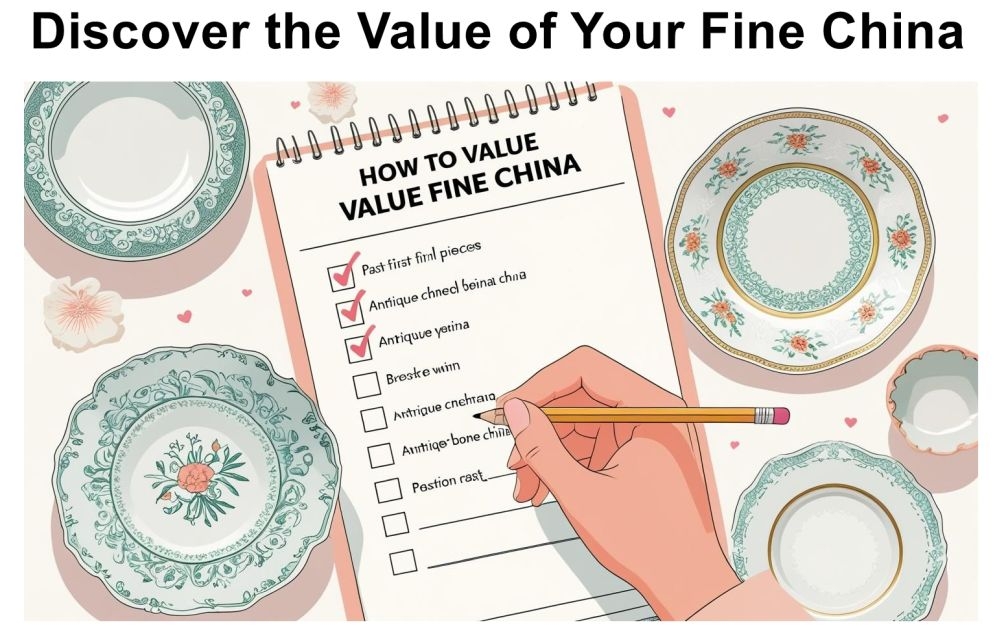
Inherited a china set?... Download my free 7-point checklist to instantly assess its potential value.
From the Studio
• Peter Holland Posters
• Sculpture Studio
